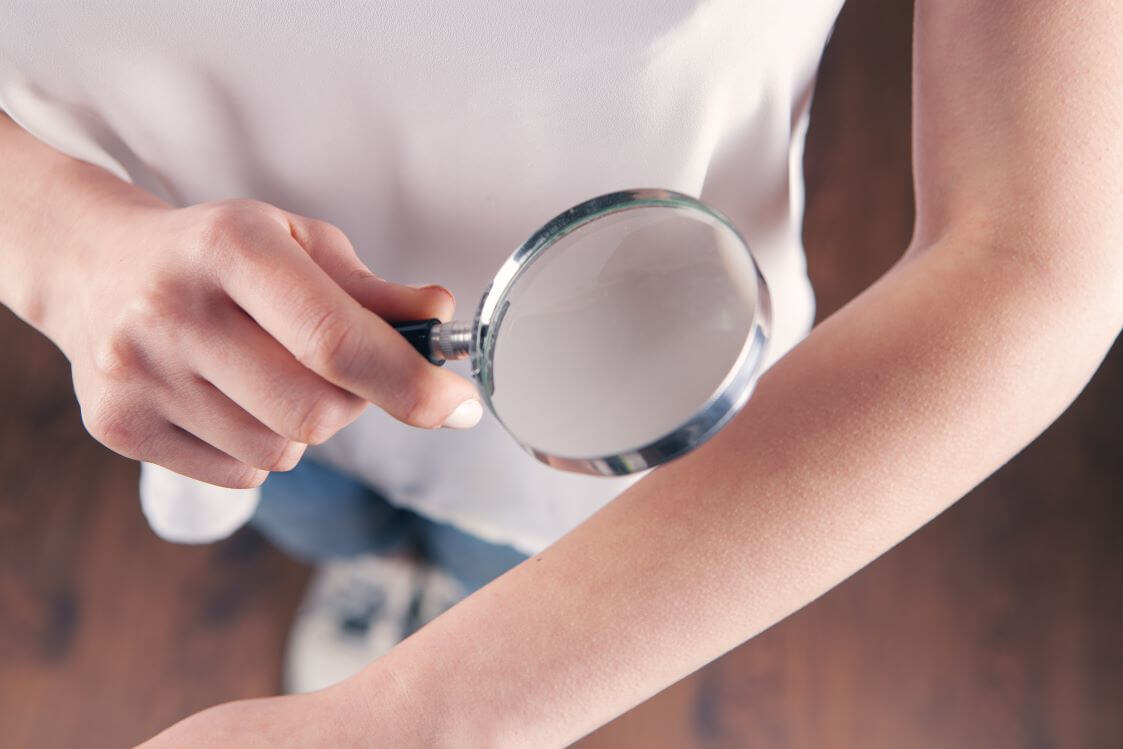You’ve likely heard that it’s important to regularly check for signs of skin cancer, but if you’ve never been taught the proper way to perform these self-checks or what you’re looking for, it can be difficult to know when to seek help. According to Dr. David Baltazar of U.S. Dermatology Partners in Peoria and Sun City West, Arizona, “Most of my patients have heard that self-examining for skin cancer is important, but few really understand what these exams entail. Since patients and their loved ones are often the first to notice skin changes, it’s important for dermatologists to take the time to educate patients on how to properly perform self-checks.” In this blog, Dr. Baltazar discusses the benefits of performing skin cancer self-exams as well as exactly what to look for and how to detect skin cancer with monthly self-exams.
Why Self-Examining for Skin Cancer is Crucial
According to research compiled by the Skin Cancer Foundation, there is bad news and good news associated with skin cancer. The bad news is that skin cancer is still the most common form of cancer in the U.S. and around the globe, and deaths caused by melanoma skin cancer are projected to rise in the next several years. The good news is, even with a serious and growing concern related to skin cancer, this condition is treatable, especially when diagnosed in the early stages. Self-exams and professional skin cancer screenings play a crucial role in ensuring skin cancers are diagnosed and treated in the earliest stages. When caught early, even melanoma, the deadliest form of skin cancer, has a 99% survival rate at 5 years. It is extremely important that individuals check for and note any changes in their skin’s appearance regularly and contact a dermatologist or other medical professional as soon as they notice these changes. This ensures they receive an accurate diagnosis and effective treatment quickly.
Understanding the ABCDEs of Skin Cancer
When it comes to identifying skin cancer, Dr. Baltazar says, “Recognizing and reporting signs of skin cancer to your dermatologist is as easy as knowing your ABCDEs. Asymmetry, Border irregularities, Color variances, large Diameter, and rapid Evolution. These are not only some of the most common signs of skin cancer, but they are the signs that are likely to indicate a concern. It is especially important to have these irregularities examined if you notice the lesions are painful, itchy, bleeding, or failing to heal quickly.”
Below, the ABCDEs of skin cancer are described in greater detail to help you recognize them during self-exams:
- A – Asymmetry – One side of a lesion is different from the other in size, shape, color, texture, or other characteristics.
- B – Border – The edges of the lesion are irregular. They often appear scalloped or poorly defined rather than a distinct round or oval shape characteristic of benign moles, freckles, and other skin lesions.
- C – Color – This may mean a variety of colors within a single lesion or a lesion that is different in color from similar marks.
- D – Diameter – Anything greater than 6 millimeters in size should be examined by a professional. For comparison, that is about the size of a standard #2 pencil eraser.
- E – Evolution – Any spot that changes rapidly is cause for concern. This can mean changes in color, size, shape, or any other characteristics. Additionally, new growths in adulthood should always be examined by a physician.
Tools and Preparation for Your Self-Exam
Before you get started with your skin check, take some time to find the right space and acquire the best materials. Ideally, you’ll need a well-lit room with a full-length mirror. Bathrooms are typically the best option, but if you have access to a full-length mirror elsewhere in your home, you can always bring in extra lighting if needed. Additionally, you should have a handheld mirror and a flashlight for examining the more difficult-to-see areas of the body. Finally, have a notepad and pen as well as a smartphone or camera available to document anything of concern. It’s important to take a systematic approach to skin cancer self-exams. Try to perform them at about the same time each month, be as thorough as possible, and work from the top of your head down.
A Detailed Step-by-Step Guide to Self-Examination
Most people know to check the face, neck, shoulders, arms, and legs for signs of skin cancer, but it’s important to consistently check all areas of the body. Even those that don’t receive much sun exposure may develop skin cancer. Specifically, you should be checking the scalp, nail beds, palms of hands, soles of feet, and the eyes.
Below, you’ll find step-by-step instructions outlining how to check for skin cancer. Your dermatologist can also walk you through this process during a professional skin cancer examination.
- Step 1 – Use a flashlight and your full-length and/or handheld mirrors to carefully examine the scalp. Move hair aside in sections checking the front and back of the scalp for any areas of concern. You can also feel your scalp for bumps or texture irregularities that may signal a concern.
- Step 2 – Look at your face carefully. This should include systematically examining the forehead, eyes, nose, mouth, cheeks, and chin for any lesions or changes.
- Step 3 – Examine your neck, collarbone, and shoulders carefully. Use the handheld mirror to see the back of your neck and shoulders.
- Step 4 – Look over your trunk, including the chest, stomach, sides, and back. Carefully note any areas of concern.
- Step 5 – Starting at your shoulder, look at each arm in turn. Bend the arms to look for irregularities in the skin when it creases at the elbow. This may look like puckering. Then, examine the backs and palms of the hands as well as between the fingers. Take the time to carefully look at the skin under and around the fingernails.
- Step 6 – Examine your hips, buttocks, and genitalia. Use a handheld mirror and flashlight if needed to see clearly.
- Step 7 – Finally, look at each leg. Starting from the hip and working down. Bend the knee to look for puckering and other concerns. Examine the tops and bottoms of the feet. Check between the toes. Look around the nail beds and under the nails for any concerns.
Documenting and Monitoring Your Findings
Once you’re ready to perform your self-exam, Dr. Baltazar recommends, “Go slowly. Especially the first time you’re performing a self-check for skin cancer. It can be very tedious, but carefully noting any moles, freckles, blemishes, or lesions each month can make a big difference. You’ll know right away if something new has appeared. There are a few different ways to document the process. Many people like to take pictures of each lesion and save them from month to month. Some take notes of the location, size, coloring, and other elements of moles in a journal. Others utilize a body map where they can document the location of each lesion. Whatever works for you and will help you quickly and easily perform skin cancer self-exams each month is fine. If you notice areas of concern, carefully photograph the spot. You can send the images to your dermatologist for review right away. They will determine when or if you need to come into the office for an in-person examination of the lesion. These images can also make it easier to track changes over time.”
When to Seek Medical Advice
When it comes to making the decision to contact a professional, Dr. Baltazar says, “It’s always better to be safe. If you notice anything that concerns you, schedule a visit with your dermatologist. At the end of the day, we would always rather see you to tell you everything’s fine rather than miss an opportunity to diagnose skin cancer early.”
Taking Charge of Your Skin Health
Early detection is one of the best preventive measures we have against skin cancer. Regular self-exams play an essential role in empowering people to become active participants in the diagnosis and treatment of all forms of skin cancer. The earlier the diagnosis, the easier it is to ensure a complete and effective treatment plan will be available.
Schedule a Professional Skin Exam Today
Whether you’ve noticed something of concern during a skin cancer self-exam or it’s time for your annual professional screening, we hope you’ll reach out to a local U.S. Dermatology Partners office. Our skilled professionals will be happy to schedule a professional skin exam, answer any questions you have, and help you achieve and maintain healthier skin. When you’re ready to get started, simply take a few moments to complete the online scheduling request form. Once a local team hears from you, they’ll be in touch to finalize the details of your visit.
Do you know someone who needs to learn more about skin cancer screening and prevention options? Please share this blog with them. We can all work together to raise awareness about skin cancer and other serious skin health concerns.
Find a location near me
or


